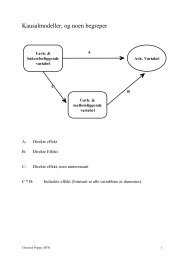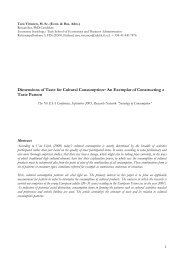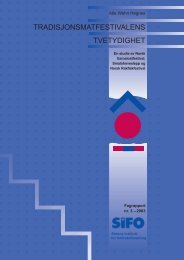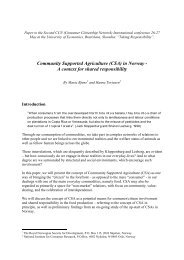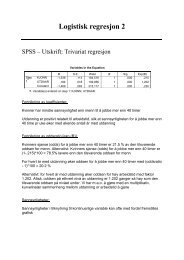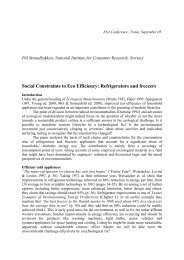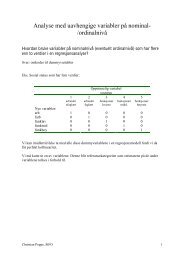Rapport nr - SIFO
Rapport nr - SIFO
Rapport nr - SIFO
- No tags were found...
Create successful ePaper yourself
Turn your PDF publications into a flip-book with our unique Google optimized e-Paper software.
36image of Terroir. They decompose it in two parts: geography and culture-history. This analyse is similarto that of D’Hauteville and Sirieix (2005), who present Terroir as a combination of geography,trade skills and time-culture. However, Sirieix brings new information concerning this analysis of Terroirimage, since she suggests that the main factor of definition for consumers is time and culture.These three analyses of Terroir point out the fact that this typical word is very difficult to define inorder to agree on consumer expectations. It is interesting to compare these diagnostic analyses in orderto compare the reasons product choice by consumers.In a study by the Centre of Research for the Study and the observation of life conditions (CREDOC,2001) for the INC, reasons of consumer choice have been demonstrated. The first consumer expectationfor labelled products is taste, while the second expectation is sanitary quality assurance. Thisstudy was conducted in 2001 shortly after the Mad Cow crisis seemed to underline consumer traceabilityresearch of. It is indeed possible that as of 2006, consumer expectations have changed in lightof the recent crisis concerning H5N1 virus which may have affected new consumer serenity. However,emergence of new sanitary policy, like the creation of AFSSA, has reassured consumers. This preoccupationconcerning research of sanitary quality has decreased. Today, it is possible that many consumersbuy more labelled products in order to adhere to a certain social vision of production or agriculture,or to be assured of product typicity rather than to have another proof of sanitary quality. Consumersare looking for typicity, but still what exactly is this new part of Terroir?6.4. Use of the Terroir image and traditionIn France, the use of the Terroir term and image emerged at the beginning of this century. Some studiesassociate this with food crises like Mad Cow and Creutzfeld Jacob disease. In addition, consumerfear has resulted in a demand of food products with greater quality insurance (CREDOC 2001), specifyingorigin, although others have linked this emergence to a social identity crisis, the WTO negotiationsor to new European agricultural policies. Regardless if consumers desire or achieve guaranteesand quality, they obviously use quality labels like Label Rouge, PDO/PGI or AB organic agriculture,which have exploded in the last ten years. To make them efficient and well-perceived by consumers, anew marketing strategy has appeared to help local food producers to commercialize their products tothese new consumers (Fort Fort, 2006). The use of advertising for local food is not only a means toraise their sales, but also a means to communicate a sign of quality, labels and guarantees. Therefore,the image of Terroir is a way to valorise a food product (Aurier 2004). The nostalgia concerning a“golden age”, based on a belief that methods of production and food products were better in the past,attracted marketing due to the possibility of this promotion. Marketing is then used to inform the consumerand to promote local food simultaneously, principally through leaflets and flyers.Terroir is a typical French dynamic concept that takes time, space and human beings into considerationat the same time (Bérard et Marchenay, 2004, p. 112). It is the main concept used in marketingfor local food products. The Idea of Terroir emerged with considerable strength in 1980 and 2002,with both the policy of decentralisation and the regionalisation of political decisions in France. Someauthors perceive Terroir as a correlation between an origin (geography, climate), culture (time andtradition) and know-how (D’Hauteville 2006 and Aurier, Sirieix, Fort 2004, Dekhili, D’Hauteville2006). This last description of Terroir, composed of cultural and geographical parts, is characteristic oflocal food advertisements, as demonstrated by the TV ad for “Roquefort” presenting an old cheesetradition in a typical territory - the Larzac. Marketing for Pélardon refers to tradition, know-how andalso the typicity of the place, in such an important way that those concepts are mentioned in everypage of the leaflet. Lagrange et al., (1995) explained this contradiction while suggesting that the territorialreputation of a product is often more the result of communication messages multiplication ratherthan a real geographical culture of the consumer.




